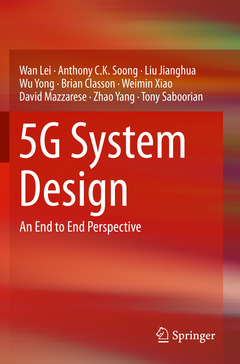Description
5G System Design, 1st ed. 2020
An End to End Perspective
Authors: Lei Wan, Soong Anthony C.K., Jianghua Liu, Yong Wu, Classon Brian, Xiao Weimin, Mazzarese David, Yang Zhao, Saboorian Tony
Language: English
Subject for 5G System Design:
105.49 €
In Print (Delivery period: 15 days).
Add to cart
Publication date: 09-2020
Support: Print on demand
Support: Print on demand
Description
/li>Contents
/li>Biography
/li>Comment
/li>
This book presents a detailed pedagogical description of the 5G commercial wireless communication system design, from an end to end perspective. It compares and contrasts NR with LTE, and gives a concise and highly accessible description of the key technologies in the 5G physical layer, radio access network layer protocols and procedures. This book also illustrates how the 5G core and EPC is integrated into the radio access network, how virtualization and edge computer fundamentally change the way users interact with the network, as well as 5G spectrum issues.
This book is structured into six chapters. The first chapter reviews the use cases, requirements, and standardization organization and activities for 5G. These are 5G requirements and not NR specifically, as technology that meets the requirements, may be submitted to the ITU as 5G technology. This includes a set of Radio Access Technologies (RATs), consisting of NR and LTE; with each RAT meeting different aspects of the requirements. The second chapter describes the air interface of NR and LTE side by side. The basic aspects of LTE that NR builds upon are first described, followed by sections on the NR specific technologies, such as carrier/channel, spectrum/duplexing (including SUL), LTE/NR co-existence and new physical layer technologies (including waveform, Polar/LDPC codes, MIMO, and URLLC/mMTC). In all cases the enhancements made relative to LTE are made apparent.
The third chapter contains descriptions of NR procedures (IAM/Beam Management/Power control/HARQ), protocols (CP/UP/mobility, including grant-free), and RAN architecture. The fourth chapter includes a detailed discussion related to end-to-end system architecture, and the 5G Core (5GC), network slicing, service continuity, relation to EPC, network virtualization, and edge computing. The fifth and major chapter describes the ITU submission and how NR and LTE meet the 5G requirements in significant detail, from the rapporteur responsible for leading the preparation and evaluation, as well as some field trial results.
Engineers, computer scientists and professionals with a passing knowledge of 4G LTE and a comprehensive understanding of the end to end 5G commercial wireless system will find this book to be a valuable asset. Advanced-level students and researchers studying and working in communication engineering, who want to gain an understanding of the 5G system (as well as methodologies to evaluate features and technologies intended to supplement 5G) will also find this book to be a valuable resource.
1 From 4G to 5G: Use Cases and Requirements.- 2 5G FUNDAMENTAL AIR INTERFACE DESIGN.- 3 5G PROCEDURE, RAN ARCHITECTURE AND PROTOCOL.- 4 5G SYSTEM ARCHITECTURE.- 5 5G CAPABILITY OUTLOOK: ITU-R SUBMISSION & PERFORMANCE EVALUATION.- 6 5G MARKET & INDUSTRY.
Wan Lei is a Huawei fellow and currently head of Wireless Standard, Huawei Tech. Co. Ltd. She led the next generation wireless research and 3GPP 4G&5G standardization work in Huawei since 2008. Before then she was a principle engineer in Ericsson Research since 2001. Her main focus areas are network topology and air-interface evolution. She is known as the expert on network topology, system-level evaluation methodology and FDD/TDD convergence in the industry. She is the initiator of 4.5G and 5G DL/UL decoupling with LTE coexistence and one of the main contributors to 3GPP 5G standardization. In the past, she led TDD/FDD frame structure merging, CoMP, LTE-Hi (3GPP R12 small cell enhancement), LTE-V2X and U-LTE (unlicensed LTE) research and standardization. She is also the inventor of the physical layer MI quality model that is widely used in the system level simulation of telecommunication systems, such a model was adopted by 3GPP, 3GPP2, WiMAX as the link to system interface for system evaluation. She has a long experience in the wireless communication industry, with the background of WCDMA, TD-SCDMA, WiMAX, LTE and LTE-Advanced. Her research interest covers spectrum and regulation, duplex evolution, network topology evolution, air interface design specifically for traffic adaptive and interference coordination solution, evaluation methodology and autonomous driving.
Anthony C. K. Soong received the Ph.D. degree in electrical and computer engineering from the University of Alberta. He is a Fellow of the IEEE and currently the Chief Scientist for Wireless Research and Standards, as well as, Vice President for US Region of 3GPP Account Department at Huawei Technologies Co. Ltd, in the US. He currently serves on the Engineering College Industrial Advisory Board of The University of North Texas. He served as Secretary and the founding board member of OPNFV (2014-2016), the chair for 3GPP2 TSG-C NTAH (the next genera
Provides performance evaluations of the 5G systems with field trial results Introduces how virtualization and edge computing will fundamentally change the way users will interact with the network Presents how 5G supports internet of things and vertical industries
© 2024 LAVOISIER S.A.S.




